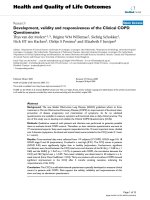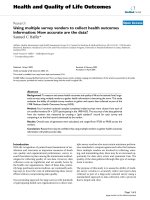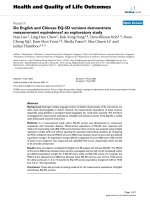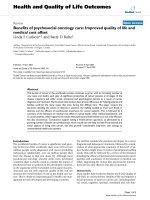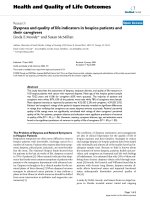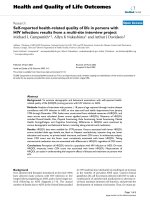Health and Quality of Life Outcomes BioMed Central Commentary Open Access Problems and solutions pot
Bạn đang xem bản rút gọn của tài liệu. Xem và tải ngay bản đầy đủ của tài liệu tại đây (249.13 KB, 8 trang )
BioMed Central
Page 1 of 8
(page number not for citation purposes)
Health and Quality of Life Outcomes
Open Access
Commentary
Problems and solutions in calculating quality-adjusted life
years (QALYs)
Luis Prieto* and José A Sacristán
Address: Health Outcomes Research Unit. Eli Lilly & Co. Spain. Av. de la Industria 30, 28108 Alcobendas, Spain
Email: Luis Prieto* - ; José A Sacristán -
* Corresponding author
Abstract
The quality-adjusted life-year (QALY) is a measure of the value of health outcomes. Since health is
a function of length of life and quality of life, the QALY was developed as an attempt to combine
the value of these attributes into a single index number. The QALY calculation is simple: the change
in utility value induced by the treatment is multiplied by the duration of the treatment effect to
provide the number of QALYs gained. QALYs can then be incorporated with medical costs to
arrive at a final common denominator of cost/QALY. This parameter can be used to compare the
cost-effectiveness of any treatment.
Nevertheless, QALYs have been criticised on technical and ethical grounds. A salient problem
relies on the numerical nature of its constituent parts. The appropriateness of the QALY
arithmetical operation is compromised by the essence of the utility scale: while life-years are
expressed in a ratio scale with a true zero, the utility is an interval scale where 0 is an arbitrary
value for death. In order to be able to obtain coherent results, both scales would have to be
expressed in the same units of measurement. The different nature of these two factors jeopardises
the meaning and interpretation of QALYs. A simple general linear transformation of the utility scale
suffices to demonstrate that the results of the multiplication are not invariant.
Mathematically, the solution to these limitations happens through an alternative calculation of
QALYs by means of operations with complex numbers rooted in the well known Pythagorean
theorem. Through a series of examples, the new calculation arithmetic is introduced and discussed.
Introduction
The evolution of the concept of health
Traditionally, the health of populations has been meas-
ured using epidemiological indicators, including the pres-
ence/absence of disease and/or death (e.g. morbidity and
mortality) [1]. These classical indicators represent the par-
adigm of a theoretical model, devised ex professo, which
help us to understand the complex reality implied by the
term "health". This model, which is generally referred to
as the "biomedical model", focuses on aetiological agents,
pathological processes and biological, physiological and/
or clinical results. The main aim of this model is to under-
stand the mechanisms causing disease so as to be able to
guide physicians in diagnosing and treating the disease
[2].
Although these epidemiological indicators are extremely
useful in depicting population health, by estimating life
expectancy and identifying the causes of death, relatively
recent changes in the way health is conceptualised have
Published: 19 December 2003
Health and Quality of Life Outcomes 2003, 1:80
Received: 22 October 2003
Accepted: 19 December 2003
This article is available from: />© 2003 Prieto and Sacristán; licensee BioMed Central Ltd. This is an Open Access article: verbatim copying and redistribution of this article are permitted
in all media for any purpose, provided this notice is preserved along with the article's original URL.
Health and Quality of Life Outcomes 2003, 1 />Page 2 of 8
(page number not for citation purposes)
also led to changes in the way health is measured and the
type and quantity of information gathered. This transfor-
mation is to a large extent the result of scientific and tech-
nical advances in medicine and improved living
conditions in terms of housing, hygiene and food. These
changes have led to increases in life expectancy and
changes in the dominant pattern of morbidity, with the
focus shifting from highly-lethal acute diseases to disa-
bling chronic conditions. When coupled with the World
Health Organization's (WHO) 1947 definition of health
as " not merely the absence of disease [but] also physical,
mental and social welfare" [3], these changes denoted the
beginning of a period in which health assessment has
gone beyond the gathering of data on the presence/
absence of disease and the quantification of individuals'
"amount of life". New "psycho-social" models have been
introduced in which consideration is also given to the
need to individuals' "Quality of Life" [4].
While the intellectual and methodological foundations of
the bio-medical model are rooted in disciplines such as
biology, biochemistry and physiology, the new psycho-
social model is founded in sociology, psychology and eco-
nomics. By moving away from a purely biological model,
the overall concept of health is enriched and a need arises
to focus on areas such as the individual's ability to operate
in society, disability, access to health services or the indi-
viduals' subjective perception of general well-being,
among others.
The integrating role of QALYs
In an attempt to integrate the biomedical and psycho-
social models, a new approach has been proposed which
can be labelled the bio-psycho-social model [5,6]. The
aim of this model is to combine the biological, individual
and societal perspectives of health in a coherent fashion.
A paradigmatic indicator within this model is the quality-
adjusted life-year (QALY), which serves as a composite
indicator allowing quality and quantity of life to be com-
bined in a single index [7].
The possibility of combining quantity and quality of life
in a single index can be combined is based on the idea
that the quality of life can be quantified by applying the
concept of "utility" [8], a concept rooted in the school of
political philosophy known as utilitarianism. Consumer
Choice Theory likewise describes how consumers decide
what to buy on the basis of two fundamental elements:
their budget constraints and their preferences. Consumer
preferences for different consumables are also often repre-
sented by the concept of "utility" [9].
Within health and health care, the greater the preference
for a particular health state, the greater the "utility" asso-
ciated with it. "Utilities" of health states are generally
expressed on a numerical scale ranging from 0 to 1, in
which 0 represents the "utility" of the state "Dead" and 1
the utility of a state lived in "perfect health". The utilities
assigned to a specific state of health can be estimated
using a series of techniques such as Standard Gamble,
Time Trade-Off or Rating Scale, or by means of pre-scored
health state sorting systems (i.e. HUI, EQ-5D) [7].
The basic idea underlying the QALY is simple: it assumes
that a year of life lived in perfect health is worth 1 QALY
(1 Year of Life × 1 Utility = 1 QALY) and that a year of life
lived in a state of less than this perfect health is worth less
than 1. In order to determine the exact QALY value, it is
sufficient to multiply the utility value associated with a
given state of health by the years lived in that state. QALYs
are therefore expressed in terms of "years lived in perfect
health": half a year lived in perfect health is equivalent to
0.5 QALYs (0.5 years × 1 Utility), the same as 1 year of life
lived in a situation with utility 0.5 (e.g. bedridden) (1 year
× 0.5 Utility) [8].
The application of QALYs in the economic analysis of
health-care activities
Over the last two decades, QALYs have become increas-
ingly widely used as a measure of health outcomes. This is
largely due to three important characteristics. Firstly, the
QALY combines changes in morbidity (quality) and mor-
tality (amount) in a single indicator. Secondly, QALYs are
easy to calculate via simple multiplication, although the
prior estimation of utilities associated with particular
health states is a more complicated task. Finally, QALYs
form an integral part of one particular type of economic
analysis within health-care, i.e. cost-utility analysis (CUA)
[8].
Whereas in Cost-Effectiveness Analysis (CEA), incremen-
tal effects are assessed in natural units such as lives saved,
years of life gained, blood pressure measured in mm of
Hg, etc., in CUA the incremental improvements in health
are measured using QALYs. A further advantage of QALYs,
is that they allow the effectiveness and cost-effectiveness
(or cost-utility) of interventions applied in very different
disease areas to be compared, even when, because of their
different outcomes, they would not be comparable within
a CEA [8].
Table 1 shows the costs and outcomes, expressed in
QALYs, generated by two alternative treatments (A and B)
for a given medical condition. In a cost-utility analysis,
costs and outcomes are compared by dividing the incre-
mental cost by the incremental outcome of one treatment
over the other, which will indicate how much each addi-
tional QALY gained with the new treatment will cost. In
the case of the figures in Table 1, the cost-utility ratio is
192.31 dollars per additional QALY gained with
Health and Quality of Life Outcomes 2003, 1 />Page 3 of 8
(page number not for citation purposes)
treatment A. Incremental QALYs are often pictured as the
difference in the rectangular areas resulting from the mul-
tiplication of life-years and utility. The QALYs from table
1 are shown graphically in Figure 1.
The fallacy of the multiplicative QALY model
Despite the advantages of using a single indicator to meas-
ure the effectiveness of health-care interventions, QALYs
have been widely criticized on ethical, conceptual and
operational grounds [10,11]. It has frequently been sug-
gested, for example, that there is no sound theoretical
basis for using QALYs nor for assuming that the social
value of health states is no more than the simple sum or
unweighted average of individual preferences obtained
using techniques such as the Standard Gamble, Time
Trade-off, etc. [10]. Despite this, and despite the fact that
a range of alternatives such as Healthy-Year Equivalents
(HYEs), Disability-Adjusted Life Years (DALYs) or Person
Trade-Offs (PTOs) [8], have been proposed to replace
QALYs, none have so far succeeded in displacing the intu-
itively attractive QALY.
One area of QALY calculations which has received little
attention is the multiplicative model which underlies the
generation of QALY values. A potential flaw in this model
is that utility values are used in the equation as if they
were obtained on a ratio, and not on an interval scale,
whereas they are in fact interval values [11]. An interval
scale is one in which the rank-ordering of objects is
known with respect to an attribute and it is known how
far apart the objects are from one another with respect to
the attribute, but no information is available about the
absolute magnitude of the attribute for any object [13]. In
the case of a ratio scale, the absolute values of points on a
scale, and not just the intervals between them, are also
meaningful, and can, for example, be multiplied.
The way in which QALYs are calculated can also be under-
stood geometrically. The points in Figure 2 indicate two
co-ordinates in a Cartesian plane limited by two axes rep-
resenting years of life along the horizontal axis and utility
along the vertical axis. Each of the points or co-ordinates
represents the number of years lived in a state of health
with a specified utility: co-ordinate A
(1,0.5)
is one year of
life lived with a utility of 0.5, co-ordinate B
(2,1)
corre-
sponds to 2 years of life lived with utility 1. The determi-
nation of the numerical value of the QALY associated with
each of these points is carried out, according to the
multiplicative model, by multiplying the value of the
sides meeting at the vertex formed by these points. In this
way, co-ordinates A and B are equivalent to 0.5 and 2
QALYs respectively. Therefore, going from health state A
to B implies multiplying the value of the QALY by 4 (B/A
= 4).
While this geometrical (multiplicative) model, which is
that normally used to calculate QALYs may be of use in
some applications (e.g. in calculating areas), it is not
appropriate for assigning numbers to points located in a
bi-dimensional space
1
(i.e. a space in which the coordi-
nates of two different points are calculated on different
types of scales) [12]. The ratios between the numerical val-
ues assigned by the multiplicative model do not corre-
spond to the ratios of the distances between the elements
(points or co-ordinates) on the plane.
Table 1: Cost-Utility Example
TREATMENT COST OUTCOMES (QALYs*)
A $1500 3.6
B $1000 1
Increment (of A over B) $500 2.6
Incremental cost/Incremental Outcome $500 / 2.6 QALYs = $192.31 per QALY gained
*(3.6 QALYs = 4 years × 0.9 Units of Utility); (1 QALY = 2 years × 0.5 Units of Utility)
QALYs pictured as rectangular areasFigure 1
QALYs pictured as rectangular areas.
0
1
0.9
0.5
TIME (Life Years)
UTILITY
24
1 QALY
Treatment B
3.6 QALY
Treatment A
∆ QALY = 2.6
Health and Quality of Life Outcomes 2003, 1 />Page 4 of 8
(page number not for citation purposes)
This can be better understood through a simple linear
transformation of the numerical scale of the utilities. The
vertical axis in Figure 3 shows a transformation Y' of the
original utilities (Y) from Figure 2 by means of the opera-
tion Y' = 2Y+1. Here, the value 0 is transformed into 1, 0.5
into 2, and 1 into 3. The type of transformation proposed
(Y' = cY+b) is the only one which maintains the properties
of the original scale [13].
The co-ordinates A' and B' in Figure 3 correspond to the
same co-ordinates shown in Figure 2; the only difference
is that the utilities (Y') are expressed on a scale running
from 1 to 3 instead of from 0 to 1. If the multiplicative
model is now applied to obtain the QALYs, the values for
the co-ordinates will be A' = 2 and B' = 6. Paradoxically,
whereas in Figure 2 there was a fourfold increase in QALY
value, the increase in Figure 3 is smaller (B'/A' = 3), even
though the position of the points is maintained.
This inconsistency highlights the fact that the ratios estab-
lished between the numerical values (QALYs) assigned by
the multiplicative model to the co-ordinates in the Carte-
sian plane do not correspond to the relationships that
these elements have with each other in reality. The reason
for this inconsistency is very simple: multiplication and
division with interval scales are permissible only with
respect to the intervals and not with respect to the scale
values [13]. Multiplying years of life by utilities makes no
sense because the utilities are expressed on an interval
scale.
QALYs revisited: The Complex Number Model
Mathematically, a solution to these limitations of the
multiplicative model is found in the Complex Numbers
Model which is rooted in the well-known Pythagorean
Theorem (if a triangle has sides of length a, b, c, with sides
a, b enclosing an angle of 90 degrees then: a
2
+ b
2
= c
2
)
[15]. The Theorem is of fundamental importance in Eucli-
dean Geometry, where it serves as a basis for the defini-
tion of distance between two points. A complex number z
is an ordered pair of real numbers (a, b) that has a repre-
sentation-point P in a plane with co-ordinates (a, b) (Fig-
ure 4). The number a is called the real part of z while b is
called the imaginary part of z. Two complex numbers are
equal if and only if their real parts are equal and their
imaginary parts are equal. The magnitude or modulus of a
complex number z is denoted |z| and defined as the dis-
tance from 0 to P, that is:
The idea of a QALY is in fact similar to a complex number,
as it is made up of a real part (Length of Life) and an imag-
inary part (Utility), in the sense that utilities are intangible
and not susceptible to direct observation. The magnitude
of the QALY cannot be calculated by multiplying both
components but by determining the modulus of such
complex composition. Thus, the QALY must be calculated
as the square root of (length of life
2
+ utility
2
).
Unlike the multiplicative model, the Complex Number
model for the calculation of the QALYs is based on oper-
ations implying the intervals separating the values on the
utility and time scales (b and a, respectively) and not the
values themselves. The QALYs thus obtained respect the
spatial relationship between the numerical values
QALYs calculated following the multiplicative modelFigure 2
QALYs calculated following the multiplicative model.
0
1
0.5
01 234
UTILITY (Y)
TIME (X) Life Years
A = 0.5
B = 2
B / A = 4
QALYs calculated following the multiplicative model after lin-early transforming the Utility scale (Y') as Y' = 2Y+1Figure 3
QALYs calculated following the multiplicative model after lin-
early transforming the Utility scale (Y') as Y' = 2Y+1.
1
3
2
01 234
UTILITY’ (Y’=2Y+1)
B / A = 3
A’ = 2
B’ = 6
TIME (X) Life Years
zc ab== +
22
Health and Quality of Life Outcomes 2003, 1 />Page 5 of 8
(page number not for citation purposes)
assigned to the elements in the Cartesian plane. Figure 5
replicates the contents of Figure 2 but assigns the QALY
values obtained from the Complex Number model to the
A and B co-ordinates. The ratio of B/A in this case is equal
to 2 ( ). Figure 6 shows the
transformation Y' of the original utilities (Y) by means of
the operation Y' = 2Y + 1. We can see that A equals 1.414
( ) and B 2.828 ( ),
which provides the same value for the ratio B/A as that
obtained before transforming the utility scale. The
Complex Number model assigns numerical values to the
elements in question so that these maintain the invari-
ance of their ratios, thus respecting the attribute's bi-
dimensionality.
Because the utility value lies between 0 and 1, the result-
ing distance obtained from the Complex Number
approach may be dominated by the variable on the X axis
(Length of Life) if it takes a large value (i.e. 75). One way
around this problem is to similarly bound the length of
life variable within 0–1 as well. Likewise, to set the maxi-
mum possible QALY value at 1, the c value initially
obtained by this procedure must be divided by =
1.4142 (as when a = 1 and b = 1 then
). To reverse the standardization, the
value resulting from this operation must be multiplied by
the actual length of life. The new equation for calculating
QALYs is therefore as follows:
Table 2 presents the QALYs corresponding to different val-
ues on the utility scale when the number of years remains
constant and equal to 1. The most noteworthy aspect of
this table is that, unlike in the multiplicative model,
whenever utility reaches its minimum value the value of
the resulting QALY is greater than 0. To some extent, it
could be said that this new way of calculating the value of
QALYs gives greater relative weight to the amount of life,
The Cartesian Plane and the graphical representation of a Complex Number (P)Figure 4
The Cartesian Plane and the graphical representation of a
Complex Number (P).
QALYs calculated following the Complex Number modelFigure 5
QALYs calculated following the Complex Number model.
0
1
1
TIME (Life Years)
UTILITY
c
b
a
P
0
1
0.5
01 234
UTILITY (Y)
B / A = 2
A = 1.118
B = 2.236
TIME (X)
Life Years
AB=+ =+105 21
22 22
.;
A =+−121
22
()
B =+−231
22
()
QALYs calculated following the Complex Number model after linearly transforming the Utility scale (Y') as Y' = 2Y+1Figure 6
QALYs calculated following the Complex Number model
after linearly transforming the Utility scale (Y') as Y' = 2Y+1.
1
3
2
01 234
B / A = 2
A = 1.414
B = 2.828
UTILITY’ (Y’=2Y+1)
TIME (X)
Life Years
2
c =+=()11 2
22
QALY
Utility
Time=
+
(
.
).
1
1 4142
22
Health and Quality of Life Outcomes 2003, 1 />Page 6 of 8
(page number not for citation purposes)
making it impossible for this to be reduced to nullity.
When dealing with the gains obtained by health care
interventions, this seems appropriate as it adds additional
weight to the mere fact of survival. For utilities expressed
with a level of precision of 0.05 units, the table can be
used to calculate any QALY; it is sufficient simply to mul-
tiply the QALY value in the last column by the number of
years in question. For example, 2 years lived in a state of
health with a utility of 0.5 would be worth 0.7906 × 2 =
1.58 QALYs, and 4 years lived with a utility of 0.7 would
be worth 3.45 QALYs (0.8631 × 4).
Figure 7 illustrates with a solid line the function which,
based on the Complex Number model, relates utility (Y-
axis) and QALYs (X-axis) when time is set to 1 year. The
function takes the form of a hyperbola in which the vertex
is located at the co-ordinate (0.7071,0). Hyperbolic func-
tions like this arise in many problems of mathematics and
mathematical physics in which equations involving
appear [16]. Figure 7 also illustrates with a bro-
ken line the function which relates utility and QALYs
according to the multiplicative model; in this case, the
function is linear and intersects the X-axis at the value 0,
indicating that when the utility of a state of health is
equivalent to 0, the value of the QALY will also be 0,
regardless of the number of years lived. The notion that a
patient gains no QALYs even when an intervention
increases life expectancy/survival would be at the very
least counterintuitive for many.
Table 2: QALYs corresponding to different utility values when Time is set to be constant (1 year)
Time (years) Utility QALY*
1 1,00 1,0000
1 0,95 0,9753
1 0,90 0,9513
1 0,85 0,9280
1 0,80 0,9055
1 0,75 0,8839
1 0,70 0,8631
1 0,65 0,8434
1 0,60 0,8246
1 0,55 0,8070
1 0,50 0,7906
1 0,45 0,7754
1 0,40 0,7616
1 0,35 0,7492
1 0,30 0,7382
1 0,25 0,7289
1 0,20 0,7211
1 0,15 0,7150
1 0,10 0,7106
1 0,05 0,7080
1 0,00 0,7071
*; when Time = 1.
QALY
Utility
Time=
+
(
.
).
1
1 4142
22
()1
2
+ x
Functions relating Utility and QALY values in the Complex Number and Multiplicative ModelsFigure 7
Functions relating Utility and QALY values in the Complex
Number and Multiplicative Models.
0
0,1
0,2
0,3
0,4
0,5
0,6
0,7
0,8
0,9
1
0 0,1 0,2 0,3 0,4 0,5 0,6 0,7 0,8 0,9 1
QALY
UTILITY
Complex Number Model Multiplicative Model
Health and Quality of Life Outcomes 2003, 1 />Page 7 of 8
(page number not for citation purposes)
Conclusions
QALYs are often represented as the rectangular area result-
ing from the product of their constituent factors: utility
and time. But that is like comparing apples with oranges:
quality (utility) and quantity (time) of life are of
essentially different "data-types" and cannot be combined
by a simple product of their numerical values. Contrary to
what is assumed, the very nature of this arithmetical oper-
ation means that the resulting QALY value is not
expressed in the same units as the time scale (years). The
QALYs in the multiplicative model are in fact square units,
i.e. units used to measure areas; they are not comparable
to units of time. The Complex Number model, while cap-
turing the dimensional nature of the time-utility
composite, is expressed in linear units, which are also
directly comparable to years of life on the time scale: the
value of the complex number is equivalent to the distance
between the co-ordinate (0,0) of the Cartesian plane and
the representation-point P of this number (see Figure 4);
the standardization of this distance by means of its divi-
sion by means we are using the same units as the time
scale. As Figure 2 showed, when the multiplicative model
was applied, the ratio between co-ordinates B and A was
equal to 4; however, when the Complex Number model
was applied, the ratio between B and A was equal to 2
(Figure 5). In general, if the ratio of two lengths is b/a, the
ratio of their areas is b
2
/a
2
. Thus the ratio is 2 for the
Complex Number Model, and 4 (2
2
) for the multiplica-
tive model solution.
This article has pointed out, in addition, that the Complex
Number model respects the bi-dimensional spatial rela-
tionships established between different combinations of
time and utility when these are represented as points or
co-ordinates on the Cartesian plane, thus making it a
more suitable geometrical model than the multiplicative
model for calculating QALYs. This new means of calculat-
ing QALYs does not mean they will be significantly more
difficult to estimate, and they can be used and interpreted
as before. Table 3, for example, shows the incremental
QALYs pictured in table 1 with the new method of
calculation based on the Complex Number model. In this
case the new form of computing QALYs attenuates the
QALY difference attributed to the intervention: from a
previous increment of A over B of 2.6 QALYs, the increase
is now 2.23 QALYs, implying, in the end, an increase in
the cost-effectiveness ratio.
The new formulation of the QALYs is noteworthy for its
less dramatic adjustment of years of life than that implied
by the multiplicative model. The maximum penalization
represented by living in a sub-optimal state of health is
capped at 30% of the total time lived in that state. In the
case of the multiplicative model, the penalization can
reach 100%, a point that to some extent contradicts our
deep-seated survival instinct. The disputed degree of valid-
ity and reliability of the measurement of utilities as well as
the doubts over the possibility of extending it to all of the
individuals in the population [10] are the greatest
obstacles so far to assigning the same relative weight to the
quality and quantity of life. By giving the QALY a real part
(Length of Life) and an imaginary part (Utility), the Com-
plex Number model provides an appropriate theoretical
framework for combining time and health preferences
into a single index, yet limiting the power of the latter to
modulate the final value of the indicator.
QALYs continue to represent the paradigm of the integra-
tion of the bio-medical and the psycho-social models and
this new approach to calculating QALYs may represent a
further step in the integration of different health
dimensions without giving up the use of mathematically
sound procedures for this purpose.
Authors' contributions
LP and JAS actively participated in the discussions that
lead to the present manuscript. Both authors participated
in writing the manuscript and read and approved the final
one.
Note
In attempting to measure the physical attributes of objects
or people, scientists and laypeople take care to measure
just one attribute of the target at a time. This is because the
measurement problem consists of developing procedures
that would permit a number to be assigned to each quan-
Table 3: Cost-Utility Example: QALYs revisited
TREATMENT COST OUTCOMES (QALYs*)
A $1500 3.81
B $1000 1.58
Increment (of A over B) $500 2.23
Incremental cost/Incremental Outcome $500 / 2.23 QALYs = $224.22 per QALY gained
*(3.81 QALYs = 4 years × 0.9 Units of Utility); (1.58 QALYs = 2 years × 0.5 Units of Utility)
2
Publish with BioMed Central and every
scientist can read your work free of charge
"BioMed Central will be the most significant development for
disseminating the results of biomedical research in our lifetime."
Sir Paul Nurse, Cancer Research UK
Your research papers will be:
available free of charge to the entire biomedical community
peer reviewed and published immediately upon acceptance
cited in PubMed and archived on PubMed Central
yours — you keep the copyright
Submit your manuscript here:
/>BioMedcentral
Health and Quality of Life Outcomes 2003, 1 />Page 8 of 8
(page number not for citation purposes)
tity of the attribute in such a way that certain relations
between the numbers reflect analogous relations between
the quantities. This procedure is possible for those
attributes whose quantities form a one-dimensional
series. In this case, the attribute can be conceived as a one-
dimensional continuum, analogous to the straight line in
geometry. Assigning numbers to quantities is analogous
to specification of the position of points on the straight
line. This focus on one attribute or dimension is usually
referred to as unidimensionality. For those attributes, like
the QALY, whose quantities form a multidimensional
series the measurement problem is more complex. Here
the problem is to develop procedures to assign a set of
numbers to each quantity (quality and quantity of life) so
that the numbers, when considered in terms of a specified
geometrical system, reflect relations among the various
quantities. The number of numbers to be assigned to each
quantity corresponds to the dimensionality of the
attribute. Thus the analogy is now with a multidimen-
sional geometrical space. Whereas in unidimensional
measurement, the attribute corresponds to the straight
line (a unidimensional space), and the quantity to a point
on the line, in multidimensional measurement or scaling,
the attribute corresponds to an n-dimensional space, and
the quantity to a point in that space. Whereas the process
of assigning numbers in unidimensional measurement or
scaling corresponds to the location of points on a line, in
terms of the order of the points, their distances from one
another, and/or their distances from an origin, the process
of assigning sets of numbers in multidimensional scaling
corresponds to locating the points in a multidimensional
space in terms of a set of relations between the points as
specified by the particular geometrical model. The geo-
metrical models that might be employed are, of course, of
many different varieties. Besides the metric spaces, such as
the Euclidean model, other non-Euclidean models might
be used [12].
Regardless of the particular model used, the nature of the
problem remains essentially the same. The meaning of the
numbers assigned to the elements in the model is speci-
fied by the model. Rules of correspondence are estab-
lished, relating elements and properties of the model to
observable data, thus converting the model into a testable
theory. If the theory is verified, numbers are assigned to
the quantities of the multidimensional attribute as
specified by the theory. Once this is done, the multidi-
mensional attribute in question has been measured [12].
Acknowledgements
Our thanks to Dr. Michael Herdman, for his careful reading of the manu-
script and helpful suggestions; an to Dr. Alfonso Casado, for his contribu-
tion to an early phase of this work.
References
1. Hennekens CH, Buring JE: Epidemiology in Medicine Little, Brown & Co.:
Boston; 1987.
2. World Health Organization: International Statistical Classification of Dis-
eases and Related Health Problems (10th Revision) WHO: Geneva; 1989.
3. World Health Organization: The constitution of the World
Health Organization. WHO Chronicle 1947, 1:6-24.
4. Testa MA, Simonson DC: Assessment of Quality-of-Life
Outcomes. N Eng J Med 1996, 334:835-840.
5. Wilson IB, Cleary PD: Linking Clinical Variables With Health-
Related Quality Of Life. A conceptual Model of Patient
Outcomes. JAMA 1995, 273:59-65.
6. World Health Organization: International Classification of Functioning,
Disability and Health WHO: Geneva; 2001.
7. Patrick DL, Erickson P: Health Status And Health Policy. Oxford
University Press: New York, NY; 1993.
8. Drummond MF, O'Brien B, Stoddart GL, Torrance GW: Methods
for the Economic Evaluation of Health Care Programmes.
2nd edition. Oxford Medical Publications: Oxford; 1997.
9. Mankiw NG: Principles of Economics Harcourt Brace & Co.: Boston; 1998.
10. Nord E: Cost-Value Analysis in Health Care: Making Sense out of QALYs
Cambridge University Press: Cambridge; 1999.
11. Duru G, Auray JP, Beresniak A, Lamure M, Paine A, Nicoloyannis N:
Limitations of the methods used for calculating quality-
adjusted life-year values. Pharmacoeconomics 2002, 20:463-73.
12. Torgerson WS: Theory and Methods of Scaling John Wiley and Sons: New
York; 1958.
13. Nunnally JC, Bernstein IH: Psychometric Theory Mcgraw-Hill: New York;
1994.
14. Macran S, Kind P: "Death" and the valuation of health-related
quality of life. Med Care 2001, 39:212-227.
15. Wells D: The Penguin Dictionary of Curious and Interesting Geometry Pen-
guin: London; 1991:106-109.
16. Lockwood EH: The Hiperbola. In: A Book of Curves Cambridge Uni-
versity Press: Cambridge; 1967:24-33.


